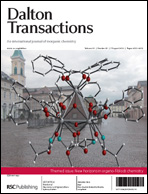A study is reported on the relative stability of trivalent bis(ligand) complexes of the form [M(LR)2N′′] for trivalent group 3, lanthanide and actinide cations, using the sterically demanding N-heterocyclic carbene ligand LR = [OCMe2CH2{CNCH2CH2NR}] (R = iPr LP, Mes LM, Dipp LD; N′′ = N(SiMe3)2). For the small YIII cation (r6-coord = 1.040 Å) and the smallest LR, R = iPr, mono, bis, and tris(LP) complexes can be made; [Y(LP)2N′′] and [Y(LP)3] have been characterised. For the larger ligands, LM and LD, only the mono(LR) complexes [Y(LM)N′′2] and [Y(LD)N′′2] can be made. For the larger CeIII (r6-coord = 1.15 Å), mono(LR) and bis(LR) complexes [Ce(LM)N′′2], [Ce(LD)N′′2], [Ce(LM)2N′′], and [Ce(LD)2N′′] can be made; structural characterisation of the latter two confirm the high degree of steric congestion. The new complex [U(LM)N′′2] has also been isolated. Despite the very similar radii of CeIII and UIII (r6-coord = 1.165 Å), the complexes [U(LR)2N′′] cannot be isolated; a surprising display of the difference between the 4f and 5f metal series. However, the six-coordinate, bis(ligand) UIV complexes can readily be isolated if smaller ancillary ligands are used; [U(LM)2I2] and [U(LD)2I2] have been fully, including structurally, characterised.


 Please wait while we load your content...
Please wait while we load your content...